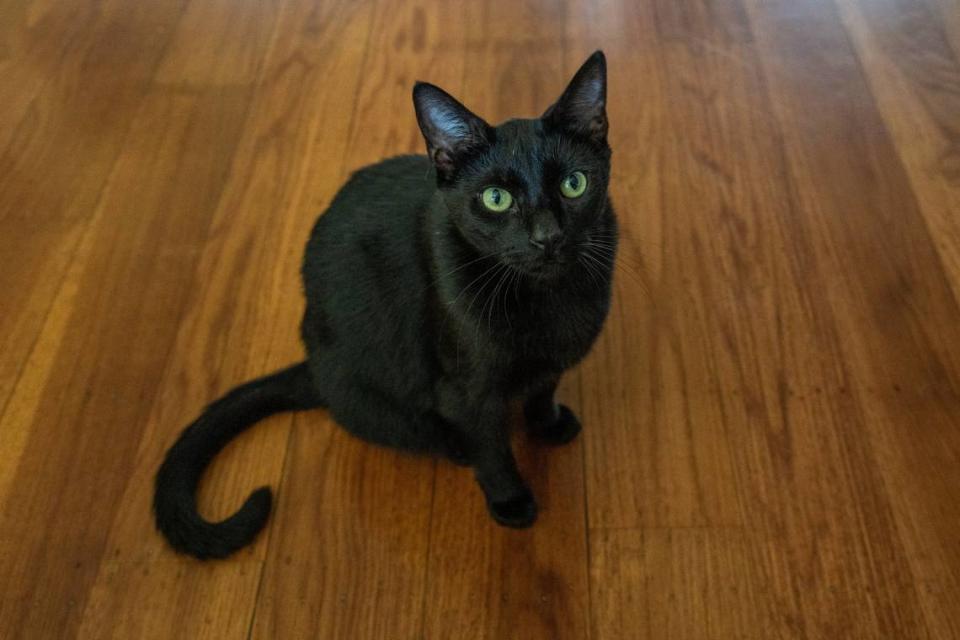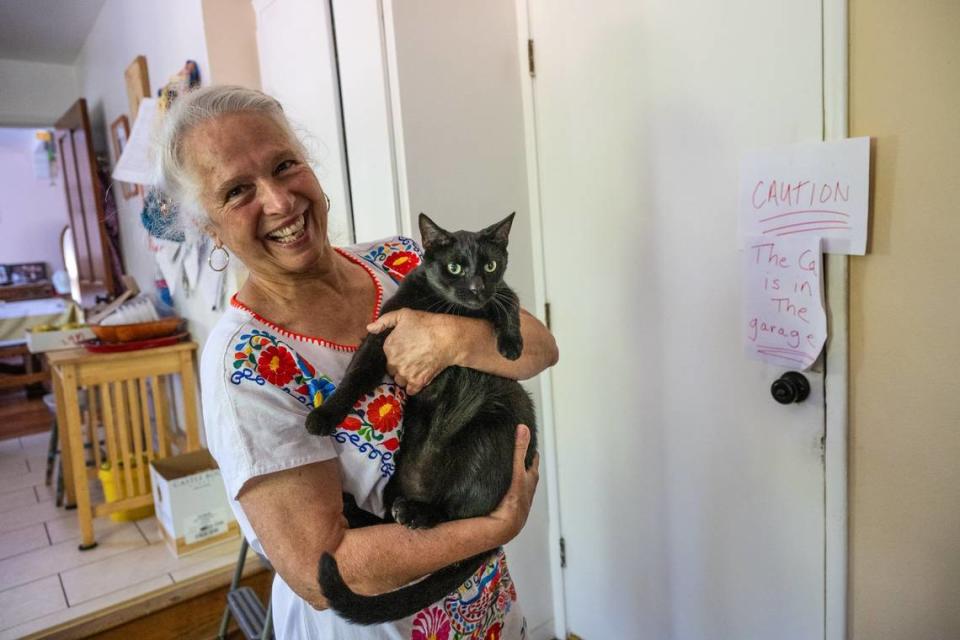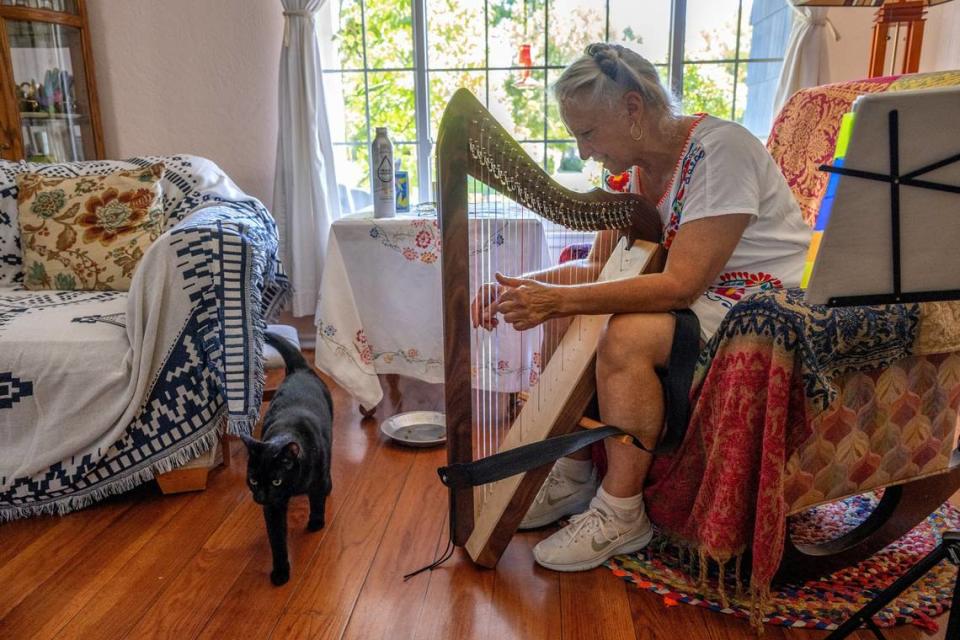This Sacramento woman’s cat went missing. Here’s what it took to get Kitty home
- Oops!Something went wrong.Please try again later.
Theresa Conley was taking her cat in early February to a veterinary office a few blocks from her Woodlake home when it happened.
The cat, who Conley calls Kitty and other members of her family know as Pinot, got loose from its carrier as Conley was getting it out of her Subaru Forester. The cat bolted across Del Paso Boulevard, faster than staff at a nearby pet grooming business had ever seen.
So began a near six-month odyssey for Conley to get her cat home, highlighting the challenges of finding a lost cat and how life can get in the way of even the most diligent searches.
Why cats go missing
This wasn’t the first time Conley’s cat went missing.
Kitty, a black cat who Conley estimates is three years old, is allowed to go inside and outside her home. Once he disappeared once on a Thursday and showed up on Monday.
“I think he got stuck in somebody’s garage or shed or something, that’s my feeling,” Conley said. “He was starving and he was happy to be back.”

Most cats don’t venture far from their owners’ homes, no more than a 34-house diameter even for cats with outdoor privileges, according to a 2017 study by University of Australia, Queensland. The diameter shrinks to five houses for cats who are strictly indoor pets, the study noted.
“If it’s an indoor-only cat, it’s not far,” said Gina Knepp, retired manager for Sacramento’s Front Street Animal Shelter. “It’s like two houses either direction hiding, like hunkered down to its mortified death.”
Front Street’s current manager Phillip Zimmerman had his indoor-only cat go missing when she got out and wasn’t wearing a collar shortly after he moved houses within his neighborhood. His cat turned up about nine months later. Zimmerman suspects she might have been living with a neighbor.
In 2021, the BBC reported that an English woman got her cat back after 20 years. The owner heard through her vet that the cat wouldn’t have survived so long as a stray and was likely taken in by a neighbor. Eventually, the cat was found in a field with a brain tumor and euthanized after getting to spend two final days with its owner.
It’s not necessarily that neighbors are acting nefariously when they take a wayward cat in. There are those cats who actively game the system, said Jamie Larson, director of animal services for the Sacramento SPCA.
“They may actually end up – my air quotes – ‘living’ at three different houses: The house behind you, the house next door to you and maybe the house behind them, too and get fed at multiple places,” Larson said. “And sometimes multiple people think they own the same cat.”
Other cats are outside because their owners abandoned them.
“For the most part, we’re seeing more and more that cats are being dumped or like driven somewhere,” said Jordan Cooper, center assistant for Happy Tails Pet Sanctuary in East Sacramento.
The initial escape
In Conley’s case, after her cat bounded across Del Paso Boulevard, she quickly went to the parking lot of the Sacramento Employment Training Agency, or SETA, thinking he might have gone there. A security guard came out and wondered why Conley was roaming the property. Conley texted him a picture of her cat.
In the days after her cat went missing in early February, Conley and her husband checked shelters. She posted to NextDoor. She also made flyers and went around on her bike to neighborhood businesses.
Around mid-March, a SETA employee texted Conley: It appeared her cat had gone to live with a colony of feral cats that gets fed weekday evenings in SETA’s parking lot area.
Feral colonies aren’t uncommon in Sacramento, with The Wildlife Society estimating 1,000 colonies and 77,000 feral cats in the city. Where municipalities once tried to kill feral cats, volunteers now work to neuter or spay these colonies to control the population and will feed them to prevent other nearby wildlife such as birds from being hunted.
Feral colonies can be good at staying out of sight during daytime. Weeks after Conley’s cat absconded, the film “No Address” went into production. On Feb. 22, pop singer Ashanti and actor William Baldwin filmed a scene on a street by SETA. Producer Robert Craig said via text in mid-August that he and his other producers had no recollection of feral cats.
Aside from there being a greater chance of feral colonies being left alone these days, organizations like Sacramento SPCA are encouraging good Samaritans who bring in seemingly-lost cats to return them to where they found them, provided the cat is healthy and a microchip scan for owner information is fruitless.
“There’s a huge movement to just keep cats out of shelters,” Larson said.
Knepp estimated that 50-60% of cats brought to shelters “are just lost.” Some never make it home. Nationally, shelters reunite just 3% of cats with their owners, with the ASPCA noting that U.S. shelters annually euthanize 530,000 cats.
Reunions happen infrequently for different reasons.
Larson said that historically, cats have the highest euthanasia rates in shelters since owners come in so infrequently to look. Sometimes, this is deliberate, Cooper noted. “Most of the cases that you’ll find in shelters where we do find… a cat that has lost its home, there’s a reason that the owner hasn’t found that cat before,” Cooper said.
Some cats, like Conley’s, aren’t microchipped. Even for those cats who are microchipped, the system isn’t foolproof, with info sometimes out of date if owners move. Larson recommended that owners of missing, microchipped cats report them to their microchip manufacturers, which can flag shelters with the cat’s missing status.
To Zimmerman, the most important thing for getting a cat home is having it wear a collar or tags. Front Street offers free tags to residents.
The shelter also participates in a program, Petco Love Lost that uses facial recognition technology to reunite lost pets with their owners. Zimmerman said the program primarily helps dogs at this point. Larson, who’s skeptical of the technology’s efficacy, said the Sacramento SPCA hasn’t signed on to use it.
In a sense, Conley’s cat was one of the lucky ones: He had an owner trying diligently to get him home and a relatively undisturbed location where he could consistently get food while he was on his sojourn. But it would be months before he came back.

Reunion challenges
When the SETA employee initially texted Conley in March with potential good news about her cat, she had gone to Oregon weeks prior for the birth of her grandchild. She remained there until May 1. In her absence, Conley enlisted her daughter Annie Conley, a 36-year-old stateworker who lives in midtown to try to bring her cat home.
Annie Conley texted the SETA employee, went to the parking lot and spotted her mom’s cat hiding between two walls.
“When he started coming toward us, he was a little skittish and he wouldn’t let us pick him up,” said Annie Conley, who would return other times, having about five sightings of her mom’s cat in all.
It’s not unusual for the behavior of a pet cat to change around ferals.
“If you take a domestic cat and put it in a feral colony, within two weeks… it reverts to its natural cat behavior and becomes kind of wild,” Knepp said.
Meanwhile, other challenges were cropping up for Theresa Conley. Around the time she returned to California, her husband went to the hospital for 10 days. Then her stepson Brian Conley died unexpectedly at 56. Two other adult children and one of their spouses in Theresa Conley’s large, blended family were also in a car accident.
“Life just hit us, right?” Annie Conley said.
Still, Theresa Conley wasn’t giving up. After her cat wouldn’t go in a Velcro-type carrier, she turned to a former coworker who volunteered with feral cats to borrow a non-lethal trap. She made multiple trips to the SETA parking lot to try to make contact with her cat.
Finally on July 31, Theresa Conley was able to get her cat into the trap, operating the door herself since she worried the door would come down on Kitty.

When Theresa Conley first brought Kitty home, she heard him crying like a baby and wondered if she’d done the right thing. The next day, her friend came to retrieve her trap and they found Kitty sleeping inside a familiar spot: a drawer under a bed. He’s since been in and out without incident.
“I think he knows he’s – this is his territory,” Conley said. “And he’s back.”

